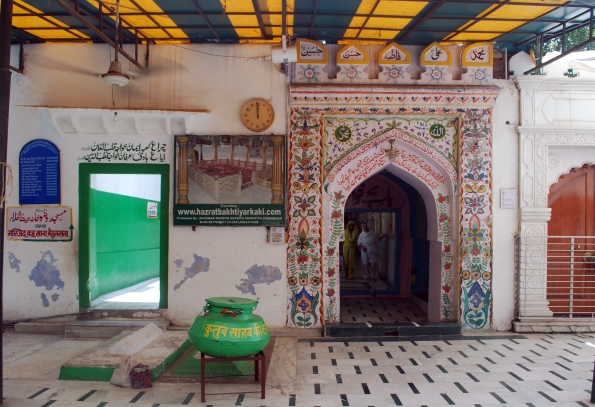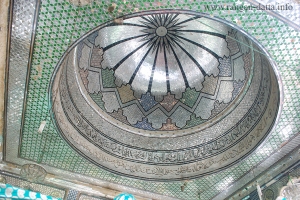Dargah of Qutbuddin Bakhtiyar Kaki, Mehrauli, Delhi
Dargah of Qutbuddin Bakhtiyar Kaki
Mehrauli, Delhi
Also see: Monuments of Mehrauli
Qutb Minar, one of Delhi’s most iconic land mark, was started by Qubuddin Aibak and was completed by his successor Iltutmish. It was not named after the founder of the slave dynasty Qutbuddin Aibak, but after a Sufi Saint Qutbuddin Bakhtiyar Kaki.

Dargah of Qutbuddin Bakhtiyar Kaki, Mehrauli, Delhi
The Sufi saint Qutbuddin Bakhtiyar Kaki lies in eternal rest in the shadows of Qutb Minar deep inside the labyrinth of Mehrauli in southern Delhi.

Entrance of Qutbuddin Bakhtiyar Kaki’s Dargah
Qutbuddin Bakhtiyar Kaki was a Muslim Sufi mystic, saint and scholar of Chishti order. He was born in Osh, in Fargana Valley (present day Kyrgyzstan) in 1173.
He was a disciple and spiritual successor of Moinuddin Chisthi and played a great role in establishing the order in and around Delhi and also has the distinction of having the oldest dargah of Delhi.
Bakhtiyar Kaki arrived in Delhi during the reign of Iltutmish and soon became a favorite of the emperor.
When Iltutmish came to know about the acute water shortage of the Mehrauli area, he built the step well of Gandhak ki Baoli, for the Sufi saint, which exists to this day

Worship material for sale at dargah entrance
Qutbuddin Bakhtiyar Kaki’s spiritual successor was Fariduddin Ganjshakar, who in turn was the spiritual master of Delhi’s patron Sufi saint Nizamuddin Auliya.
Sadly the Dragah of Qutubuddin Bakhtiyar Kaki has always been under the shadows of the most illustrious dargah of Nizanuddin.
But the shrine is a favorite to locals and people irrespective of religion visit the dargah everyday to pay homage to the great Sufi saint.
Even during his lifetime Qutubuddin Bakhtiyar Kaki was centre of attraction for Sultans to beggars and from travellers to spiritual seekers.

Entrances to the Dargah of Qutubuddin Bakhtiyar Kaki
Miracles were not uncommon in Bakhtiyar Kaki’s life but the miracle that leads the list is the miracle of Kaks or breads.

Ornamental dome of Bakhtiyar Kaki’s Dargah
Legend has it that Bhaktiar Kaki never accepted any donation form his followers, leading to extreme poverty and hunger, something not uncommon in Sufi philosophy.
This forced Bhaktiar Kaki’s wife to beg for bread leftover from the local baker.resulting into regular humiliation from the baker’s wife.
Bakhtiyar Kaki on hearing this forbade her wife to beg for food and instead told her to collect the bread from his prayer alcove. Miraculously the prayer alcove was always full of kaks or breads.
Sadly Bhaktiar Kaki’s wife shared the secret with the baker’s wife and the breads never appeared again (belief is that miracles must be kept to one’s self else they never repeat and/or cease to yield the desired result), but the name stuck.

Devotees offer prayer at the grave of Qutubuddin Bakhtiyar Kaki
According to popular Sufi believe a tomb of a holy man sanctifies the area around it and a burial in the vicinity can provide a short cut to heaven.

A grave in the dargah complex
The dragah complex of Qutabuddin Bhaktiar Kaki has several burials including a few later Mughal emperors like Bahadur Shah I, Shah Alam II and Akbar II.
Bhadur Shah II, the last Mughal Emperor has also had the wish of being buried next to the dargha but sadly had a different tale to tell. He lies buried in Rangoon, while his planned resting place remains vacant in Mehruli in Delhi.
There are several other royal extension next to the Dargah of Bakhtiyar KaKi which includes the Zafar Mahal and Moti Masjid, the royal tombs are all housed inside the Moti Masjid or the Pearl Mosque.

Another grave at the dargah complex
Apart from the royal graves the complex houses innumerable number of graves of every possible shape and size thus adding not only to the architectural diversity of the complex but also adding splashes of colour to the already colourful Dragah of Qutubuddin Bhaktiar Kaki.
The grave of Qutbuddin Bakhtiyar Kaki was originally simple but it has been modified over the years.
It presently consists of a marble balustrades enclosure and surmounted by a highly decorated dome resting on ornamental pillars. Dozens of devotees visit the dargah to pay tribute to the great Sufi saint every day.

A highly ornate tomb in the Qutbuddin Bakhtiyar Kaki Dargah Complex, Mehrauli, Delhi
Apart from the scattered grave, which turns the place into a sort of necropolis, there are several other structures in the dargha complex of Qutbuddin Bakhtiyar Kaki.

A decorative gateway
The entire dargha complex of Qutbuddin Bakhtiyar Kaki is connected by a complex network of passageways passing through arched gateways and leading to large open courtyards and assmebly halls.
There are several decorative gates, with intricate mosaic and stucco works, leading from one complex to the other.
The dargah complex also houses three mosque and a a minarat, resembling the Qutb Minar.
There are several halls including Naubat Khana (Drum House), Majlis Khana (Assembly hall) and Tosh Khana (Robe Chamber).
Special Thanks: Fellow heritage enthusiast and blooger Sahil Ahuja deserves a special thanks for not only guiding me through the Dargah of Qutbuddin Bakhtiar Kaki but also proving me valuable information through his blog.













A recent admirer of your work..Maybe an award pretty much cannot fathom your expanse yet I nominate you for this blogging award…Please follow up the rules… https://ruchirabiswas.wordpress.com/2016/01/28/the-blogging-award/
Thanks Ruchira for admiring my blog. But sorry I don’t accept awards, hope you don’t mind.
Keep blogging…
No no not a problem..:-) Thanks for the reply!
Your blogposts are true collectibles!
Thanks!!
Thank you for sharing this article. I have been to Delhi countless times, but Dargah of Qutbuddin Bakhtiyar Kaki was not known to me. Loved reading about it, next time I am certainly visiting this divine Dargah.
Dear Ketaki, next time in Delhi, don’t miss out the Dargah of Qutbuddin Bakhtiyar Kaki
nice presentation
Thanks
Nice One!!
Thanks
Nicely presented . Qutbuddin Bakhtiar Kaki Dargah was the only place where I use to get peace. I use to visit dargah whenever I use to get time and share my things in my prayer but now I am staying overseas and missed those times. Hopefully after few years i will be able to visit dargah again . I also used to visit Yogmaya Temple on the same time.Thanks ranjan
Thanks Jamal for sharing your experience in Qutbuddin Bakhtiar Kaki Dargah, it is really an oasis of peace.
Fascinating account which arouses curiosity about the sufi saint and the dargah ambience and architecture.
Thanks. Please do visit the amazing dargah